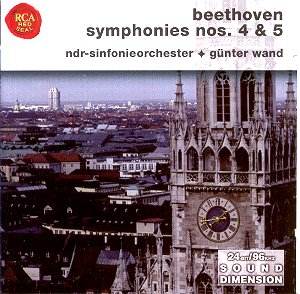Remastering in 24 bit/96 kHz Sound Dimension – RCA’s
much vaunted technology – lets us hear even more of Wand’s intensely
convincing exposition of orchestral detail in these thoroughly recommendable
performances recorded in 1987 and 1988. His control of individual movements
- and the overarching span of the symphonies - is exemplary and even
where one finds oneself ambivalent about the results (the scherzo in
the Fifth for example) one still remains impressed by the conviction
with which he maintains pulse and direction. If I concentrate rather
more on the B flat Symphony it’s not because I found the Fifth less
than naturally sprung but rather more because the earlier work reveals
if anything even more of Wand’s great gifts as a Beethovenian.
The Fourth does indeed receive a marvelously and comprehensively
sensitive reading. The first movement’s adagio opening is properly grave
but its subsequent relaxation into the Allegro vivace is activated with
the most acute organisation of internal rhythm. There’s a cogent rightness
to Wand’s tempo, a reluctance to indulge deep black bass lines, and
most perceptively a constantly inviting attentiveness to the frequently
humour-laden wind choirs. The bassoon takes a prominent share and is
laudably equipped to do so. Otherwise the verdancy of the winds reminds
one that this is a much undervalued and occasionally orchestrally prescient
Symphony. The consonance and seriousness of the Adagio possesses an
elevating seriousness made even more so by the violin entries, which
are etched with exceptional tenderness but quite without sentimentality.
Wand certainly doesn’t press ahead too swiftly in the scherzo; the orchestral
sound here is blended splendidly, the recording really first class,
orchestral discipline maintained. He observes the ma non troppo
indication of the finale; plenty of clarity here as well as bite and
once more really razor sharp string entry points and renewed admiration
for the NDR wind principals who contribute so much to the success of
this performance, one which sits in broadly speaking the Schmidt-Isserstedt
tradition (one of the most undervalued cycles around).
The Fifth opens in imposing but neither relentless
nor grandiloquently supine mood. Wand maintains direction and resilience
in matters of tempo and internal balance here and in the slow movement
he sets a reasonable tempo and generates incipient tension within it.
I did find the Scherzo rather heavy and emphatic (it was equally so
in his 1992 traversal) but as I said Wand’s genuine seriousness of intent
is also noteworthy. He gives full rein to potential for colour in the
finale with some chirping woodwind to the fore.
These are strongly imaginative and honest performances.
Splendidly played and recorded they embody central virtues of Beethoven
performance with undeviating naturalness.
Jonathan Woolf

